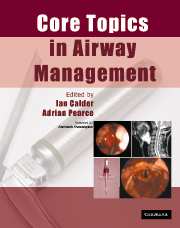Book contents
- Frontmatter
- Contents
- List of contributors
- Preface
- Acknowledgements
- List of abbreviations
- 1 Anatomy
- 2 Physiology of apnoea and hypoxia
- 3 Physics and physiology
- 4 Cleaning and disinfection of airway equipment
- 5 General principles
- 6 Maintenance of the airway during anaesthesia: supra-glottic devices
- 7 Tracheal tubes
- 8 Tracheal intubation of the adult patient
- 9 Confirmation of tracheal intubation
- 10 Extubation
- 11 Light-guided intubation: the trachlight
- 12 Fibreoptic intubation
- 13 Retrograde intubation
- 14 Endobronchial and double-lumen tubes, bronchial blockers
- 15 ‘Difficult airways’: causation and prediction
- 16 The paediatric airway
- 17 Obstructive sleep apnoea and anaesthesia
- 18 The airway in cervical trauma
- 19 The airway in cervical spine disease and surgery
- 20 The aspiration problem
- 21 The lost airway
- 22 Trauma to the airway
- 23 Airway mortality associated with anaesthesia and medico-legal aspects
- 24 ENT and maxillofacial surgery
- 25 Airway management in the ICU
- 26 The airway in obstetrics
- Index
19 - The airway in cervical spine disease and surgery
Published online by Cambridge University Press: 15 December 2009
- Frontmatter
- Contents
- List of contributors
- Preface
- Acknowledgements
- List of abbreviations
- 1 Anatomy
- 2 Physiology of apnoea and hypoxia
- 3 Physics and physiology
- 4 Cleaning and disinfection of airway equipment
- 5 General principles
- 6 Maintenance of the airway during anaesthesia: supra-glottic devices
- 7 Tracheal tubes
- 8 Tracheal intubation of the adult patient
- 9 Confirmation of tracheal intubation
- 10 Extubation
- 11 Light-guided intubation: the trachlight
- 12 Fibreoptic intubation
- 13 Retrograde intubation
- 14 Endobronchial and double-lumen tubes, bronchial blockers
- 15 ‘Difficult airways’: causation and prediction
- 16 The paediatric airway
- 17 Obstructive sleep apnoea and anaesthesia
- 18 The airway in cervical trauma
- 19 The airway in cervical spine disease and surgery
- 20 The aspiration problem
- 21 The lost airway
- 22 Trauma to the airway
- 23 Airway mortality associated with anaesthesia and medico-legal aspects
- 24 ENT and maxillofacial surgery
- 25 Airway management in the ICU
- 26 The airway in obstetrics
- Index
Summary
Difficulty with the airway and cervical spine disease are associated because adequate flexion/extension movement at the cranio-cervical junction is an essential requirement of airway management.
The three main problems are as follows:
Difficult direct laryngoscopy.
Post-operative airway obstruction.
Spinal cord damage.
Difficult direct laryngoscopy
This is common when the occipito-atlanto-axial complex is involved by disease. Osteoarthritis/cervical spondylosis can involve the upper two cervical vertebrae and their joints, but top end disease is most often due to rheumatoid arthritis, tumours and iatrogenic interventions (fixation devices) (Figures 19.1 and 19.2).
Poor mouth opening is common in cervical disease. There is an association between cervical arthritides, especially rheumatoid and temporo-mandibular joint (TMJ) disease. Impaired cranio-cervical extension has been shown to prevent full mouth opening. The mechanism is uncertain.
Grade 3 laryngoscopy occurs in about 7% of patients with cervical spondylosis, but the prevalence can be over 40% in patients having surgery for cervical rheumatoid arthritis.
Post-operative airway obstruction
The reported incidence of this has been as high as 6%, with re-intubation being required in 2%. The classic cause is a haematoma in the wound after anterior cervical surgery. However, the haematoma may be small, or even absent. The problem seems to be due to interference with venous and lymphatic drainage, and it is commoner after long operations. Airway obstruction due to tissue swelling is a particular problem after front and back surgery, where a patient has anterior surgery followed by posterior surgery in the prone position. Airway obstruction after cervical surgery is sometimes neglected because of misunderstandings about symptoms and signs.
- Type
- Chapter
- Information
- Core Topics in Airway Management , pp. 147 - 150Publisher: Cambridge University PressPrint publication year: 2005



